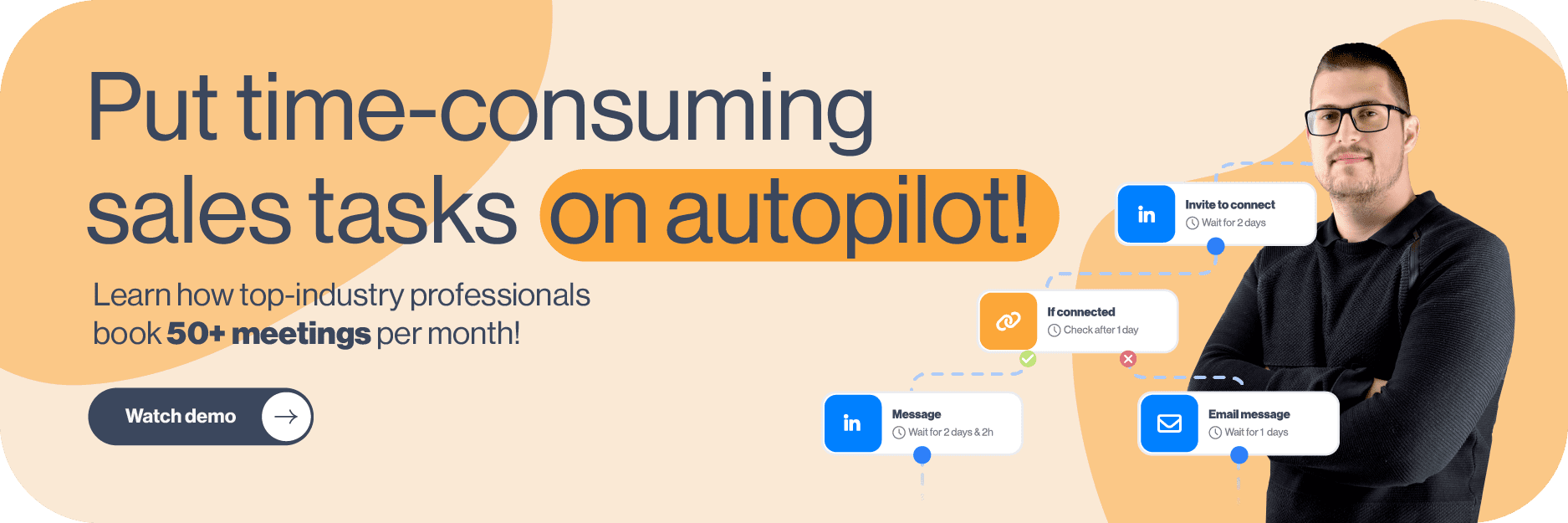If you are doing LinkedIn outreach, how you write your Summary is of vital importance. Do not believe us? Then let’s demonstrate with one of the most common scenario examples, which starts like a bad joke.
An SDR sends a LinkedIn connection invite.
Person on the other end of the ’’line’’:
My, my... Who do we have here? Who are you?
*Sees a profile picture and a name*
What do you want?
*Sees a message* *Goes to profile*
Ahh... An SDR.
*Goes to profile and scrolls down to Summary*
Empty. No valuable information or expertise.
If they didn’t take the time to properly introduce themselves and show who they are, I won’t have time for this connection either.
*Clicks Ignore*
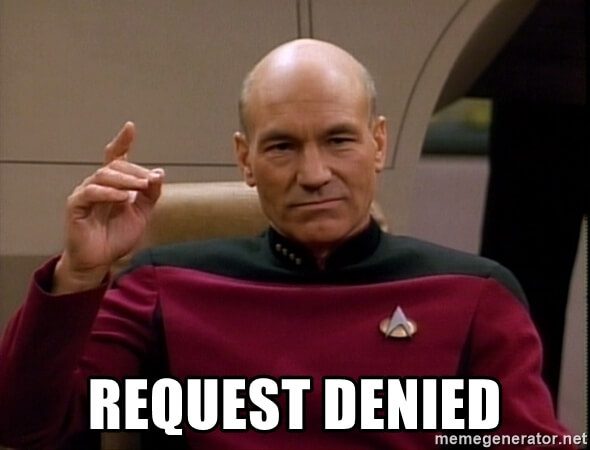
See what they did there? They tried to make indirect connections and confirm the validity, but you denied them the opportunity, even though you are the one who reached out.
At the end of this article, you will learn:
- How to write a LinkedIn summary;
- Best practices;
- Mistakes to avoid;
- Tips and tricks;
- Examples that will inspire you.
All this, so you can improve the connection requests acceptance rate, which leads to sales.
So what is the magic formula for the scenarios at the beginning of the article to disappear? Let’s start with a Good Quality Summary + Optimized LinkedIn profile.
Benefits of optimized LinkedIn profile and a summary
Now, when it comes to attracting new visitors and leads, apart from the optimized LinkedIn profile, the key element on your profile is the Summary, aka About section.
With the well-optimized account and the Summary, your profile will be shown in search results more often. This means you’re directly increasing your chances to connect with your target audience, thus reaching your goals.
Flipping the other side of the coin. When doing cold outreach, prospects will see your About section, and they will indirectly feel more connected to you.
They will know who exactly contacted them, the value you provide, your expertise, and that you know what they are talking about. They will know you are legit - and not as you are trying to catfish them on some level.
Key elements of a well-optimized LinkedIn profile
Let’s first talk briefly about your LinkedIn profile optimization. This is for all the users out there: Whatever your current job description or a company are, you need to be aware of the fact that, as an individual, you represent yourself as well as the company. Therefore, your LinkedIn profile should be as optimized as possible.
If you are an SDR, then this is that much more important. You need to make sure to optimize your profile for LinkedIn lead generation, as well.
In short, a well-optimized LinkedIn profile should include:
- A representative profile and cover photo (preferably company branded with a taste);
- A catchy LinkedIn headline with keywords;
- An interesting, unique, and keyword-rich summary;
- Your job position, accomplishments, and work history.
After you complete the headline and photos setups, the next thing that you should take care of is creating a compelling summary.
LinkedIn summary: Definition and purpose
LinkedIn Summary, also known as the LinkedIn About section or Bio, is the part on a user's profile right above the Featured, Activity, and Work experience sections. It is usually a few-paragraphs-long-text and one of the first things the visitors notice on your profile.
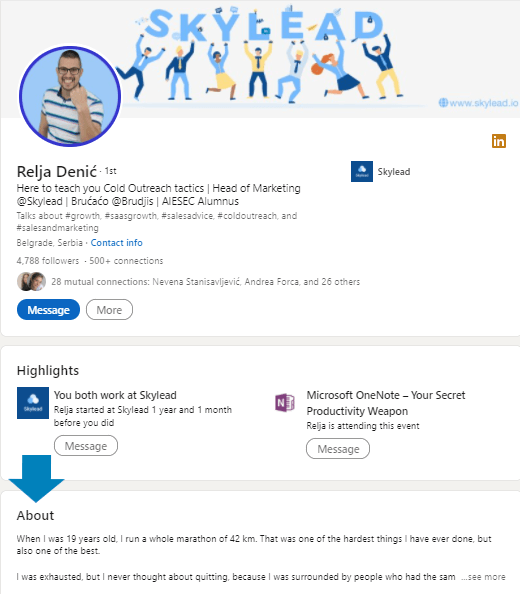
According to Rain Group’s “Top Performance in Sales Prospecting” Research, 82% of buyers research providers on LinkedIn before responding to a cold outreach message.
While the headline is there to appeal to somebody to visit your profile, the LinkedIn About section for SDRs is a place that lets people learn more about who you truly are, and encourages them to take certain actions (connect, schedule a Demo or work with you).
In other words, it is a place where you’re able to introduce yourself, give visitors a clear message of who you are, what your career story and goals are, what you are professionally known for, what drives you, and what value you can bring to them.
This section of 2600 characters is the only place where you can express your personality and connect with your prospects on a deeper level. Plus, this is the place where you can trigger the leads to take the kind of action you want them to.
Common mistakes whilst writing the LinkedIn summary
Before we present you with LinkedIn Summary examples, let first go over the most common mistakes that we noticed sales reps made.
1. Writing your profile for recruiters, not prospects
As basic as it is, this mistake does happen in the sales world. It usually happens due to a previous job search or completely forgetting the importance of the About section as is. When reaching out, be sure to update your summary so it doesn't address the wrong audience, such as recruiters and hiring managers, rather prospects and customers.
2. Non-existent LinkedIn summary
The biggest mistake the users make is leaving the summary completely blank or just repeating the work history. When you do that, other users won’t perceive you as professional, rather as plain jane/john who, as a salesperson, has no value to offer. Consequently, they will leave your profile quickly.
3. Dull looking one-paragraph LinkedIn summary
Another mistake we see often is for sales reps to write the entire summary in one long paragraph. As much as you think the content itself is interesting, unstructured and unorganized paragraphs will repel your prospects, and you will look sloppy in return.
Therefore, you need to break the summary into a few smaller paragraphs, to allow the lighter read and to get your point across.
To help you understand the examples and how they work, let's go over how to best write a LinkedIn summary as well as a few tips on what to include in it to maximize your connection acceptance rate, number of leads, and sales.
How to write a great LinkedIn summary
There is no one-size-fits-all when writing a LinkedIn summary. However, there are some guidelines SDRs should follow.
Remember: Sales is all about building genuine connections, so for the beginning, keep in mind to humanize your overall approach. Furthermore, one glance at your profile allows users to read only the first 300 characters of your summary. So at this starting point, you’ll have to get your readers hooked enough for them to read your full summary.
Example:

Once you attract their attention, you have to give them a reason to engage with you. To stand out from other LinkedIn profiles and connect with your ideal prospects, answer the following “the big four” questions:
Who are you, and what are your main work goals?
If you wish to reach new clients, answering this question will state your purpose. You will know what to focus on in order to introduce yourself to prospects.
Example:

What are you passionate about and why (customer-wise)?
To build a relationship and be more trustworthy, show your prospects what inspires you and why you love your job. Make sure to include why the prospects should choose your company. Do it indirectly.
Example:

What is your job experience, and what have you accomplished?
By providing info on your accomplishments, you’ll establish expertise and show your prospects that they can count on you. Ideally, include the proven metrics of your success.
Example:
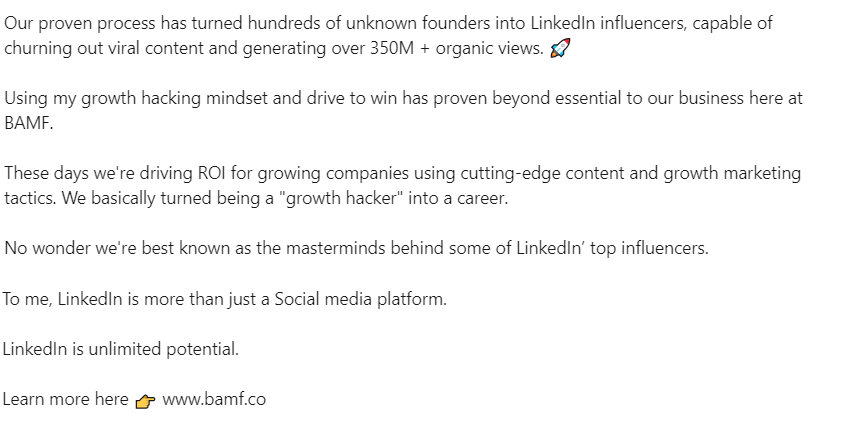
How can your product/service help prospects reach their goals?
As a salesperson, do what you know to do best - show your prospects the benefits of working with you and using the product/service and how it can help them. However, don’t get too salesly.
Example:

After you answer these questions and get done with the main part, you’re ready to go further through the process.
Tips and tricks to make your summary more attractive and interesting to prospects
To enrich the four previous questions, here are some useful tips that will help you write an eye-catching Summary:
- Write your summary in the first person;
- Don’t be afraid to add some personality;
- Include some key search terms that your prospects will likely search (it will appear higher in LinkedIn search results);
- Add a context to your career;
- Let your summary be about the prospects and their goals also;
- Write common problems that you solved while focusing on the prospects greatest pain points;
- Speak about your biggest accomplishments;
- Share real metrics, awards, and figures about your accomplishments;
- Break up the content into short paragraphs and bullet points;
- Include a CTA message at the end;
- Bold or italicize parts of the text;
- Use emojis but do not overload;
- Include your contact information - make it easy for prospects to reach back to you;
- Use brief sentences.
5 best LinkedIn summary examples perfect for sales
Without further ado, here are the five best LinkedIn summary examples for sales reps or SDRs that you can use as an inspiration for creating your description.
We’ll present different summaries types and emphasize what dominant tips they used from the checklist above.
#1 LinkedIn summary example – Show your personality
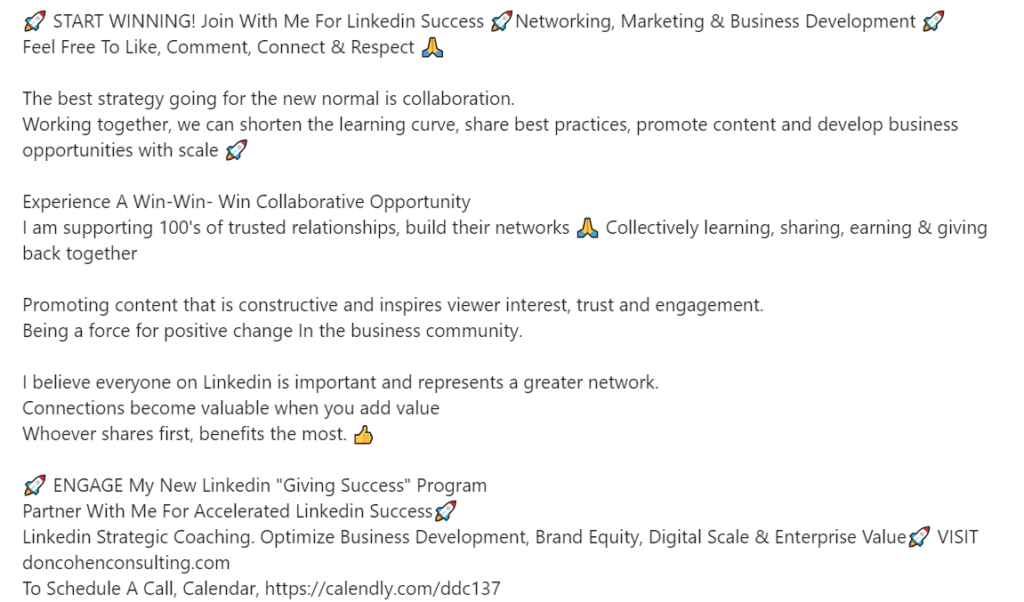
The great thing about this example is the author’s expression, perky personality. Right off of the bat you can feel the author’s uplifting energy. Furthermore, the author’s willingness to help and inspire others comes across effortlessly.
This example also shows how collaboration and building trustworthy relationships are important to the author, which makes the reader feel more connected to them.
On the technical side - there is a strong hook statement that is promising and instantly attracts new readers. They also included a few searchable keywords, which are great for getting more visits.
To strengthen their expertise, they expressed their accomplishments, and to make their summary earn more conversions of any kind there are CTAs included.
Tips applied:
- Added personality;
- Hook statement;
- Keywords included;
- The value offered to the prospect as well;
- Metrics about accomplishments included;
- CTA and website included.
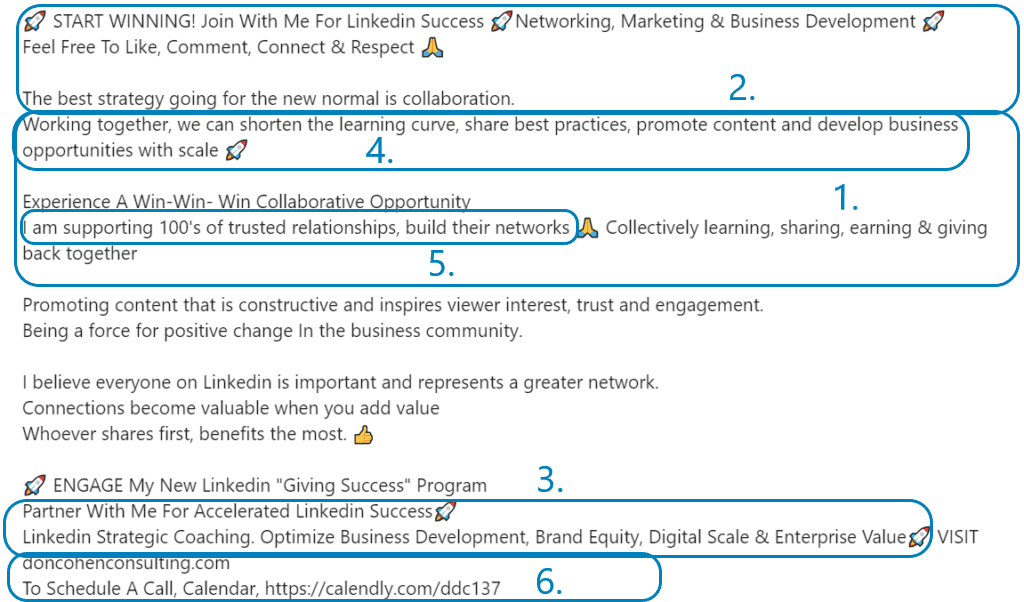
#2 LinkedIn summary example – Show accomplishments and win credibility
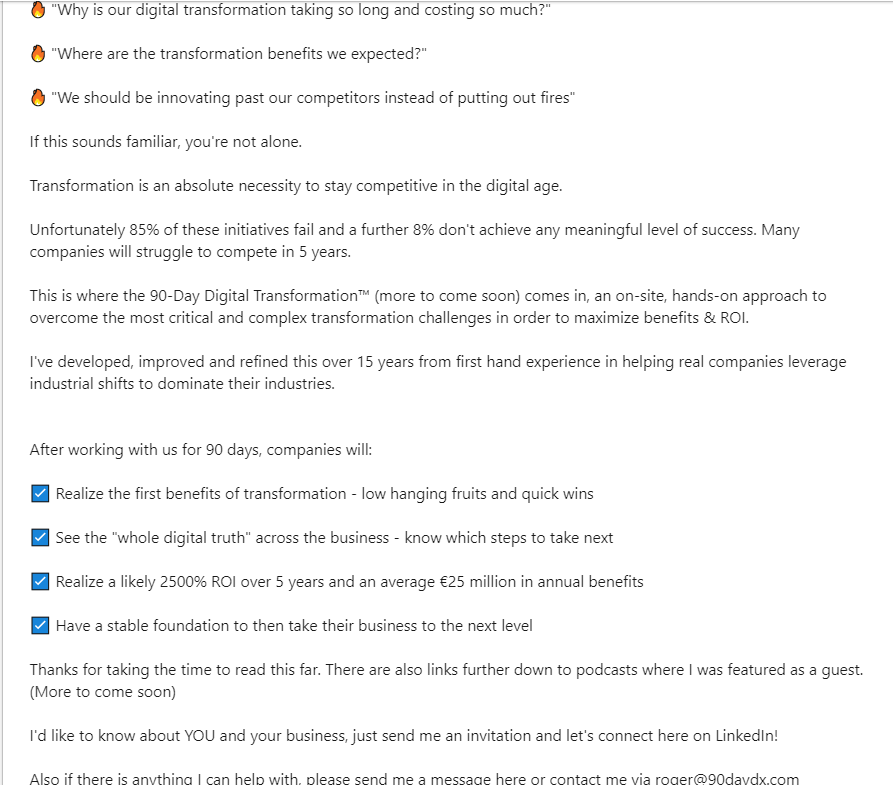
This example starts with the most alluring intros of them all - questions his target audience wishes to know. This is an excellent example as it is pretty result-oriented and a great conversation starter. If you are aiming to signify the benefits of using your services or products, this is the way to go.
Demonstrating your business results and collaborations in your summary is a great way to increase conversions and get a lot of sales, especially if you include real proof. In other words, to get new sales, show what influence your product or service may have on other people’s lives or businesses.
Tips applied:
- Hook statement in the questions form;
- The value offered to the prospect;
- Contact information included;
- CTA included;
- Emojis as bullet points used;
- Text broken into small paragraphs for easier read and accomplishments;
- Summary about the reader.
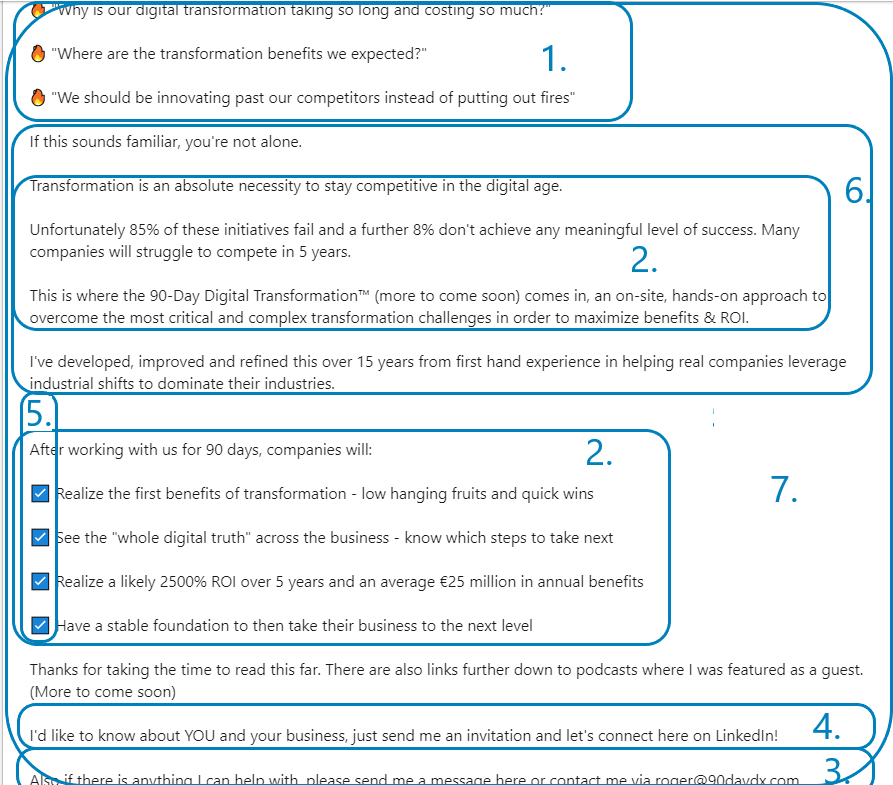
#3 Example LinkedIn summary – Sincere, short and niche-focused
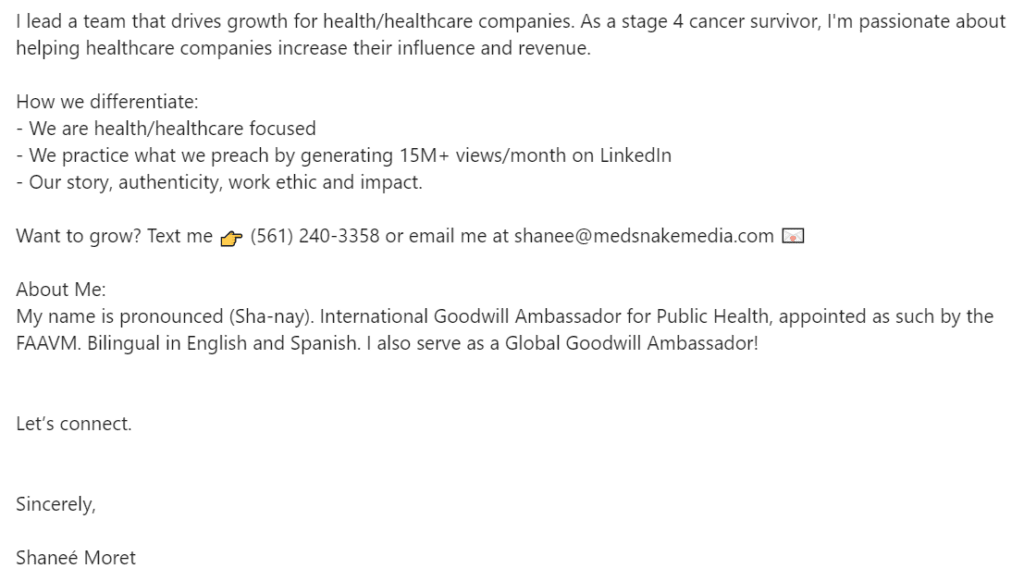
A lot of decision-makers on LinkedIn don’t have much time to read your summary, so if you need to reach them only, you can apply this example. The short version of the summary can do a great job of growing your conversions, especially if your business is narrowly focused.
This kind of self-presentation, in summary, can be very memorable as it contains personal history, the reason behind the company, and it goes straight to the point without wasting a lot of the reader’s time.
Tips applied:
- Value offered to the prospect;
- Added personality;
- Context to the career added;
- Metrics about accomplishments included;
- CTA included;
- Contact information included;
- Minimal use of Emojis and bullet points;
- Text broken into small paragraphs for easier reading.
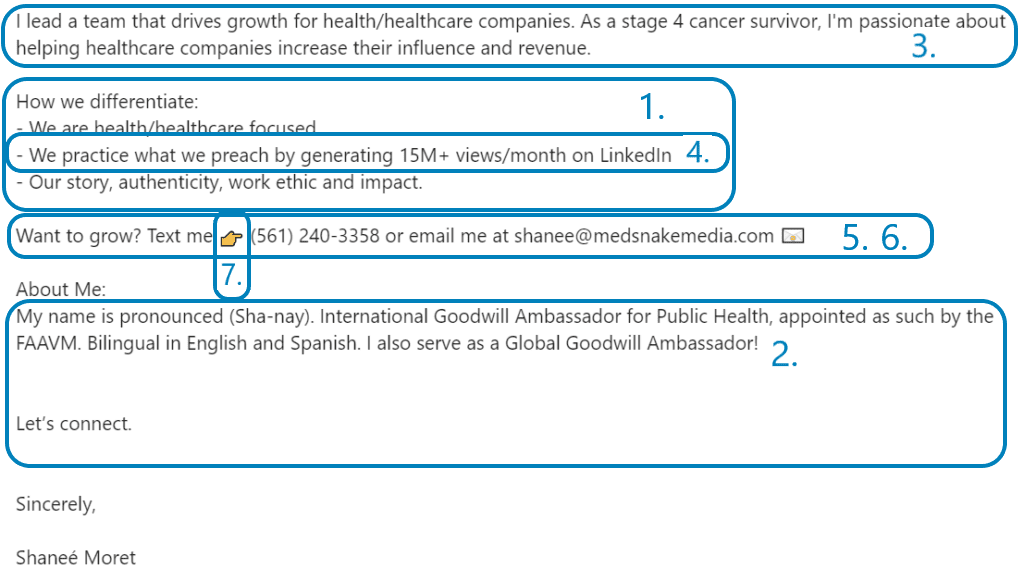
#4 LinkedIn summary example – Value everywhere you turn

This is another example with the great hook in the intro, which uses questions, but this time, it demonstrates the pain points as well.
Text is broken into paragraphs, and each one is emphasized with either value, pain point, or empathetic statement. This combination brings great results in practice, so you can use it as an inspiration in your creative process.
Tips applied:
- Hook statement in the questions form;
- Keyword included;
- Summary written in the first person;
- Value offered to the prospects;
- CTA included;
- Emojis as bullet points used;
- Text broken into small paragraphs for easier read;
- Common problems solutions demonstrated while focusing on the prospects biggest pain points.
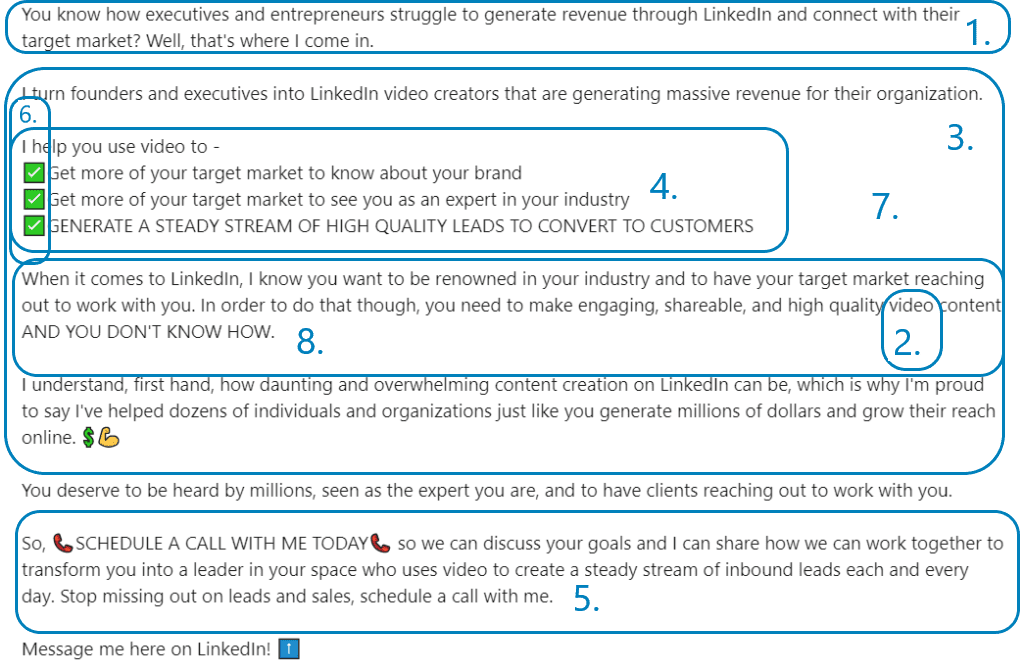
#5 LinkedIn summary example – The ”big four” answers
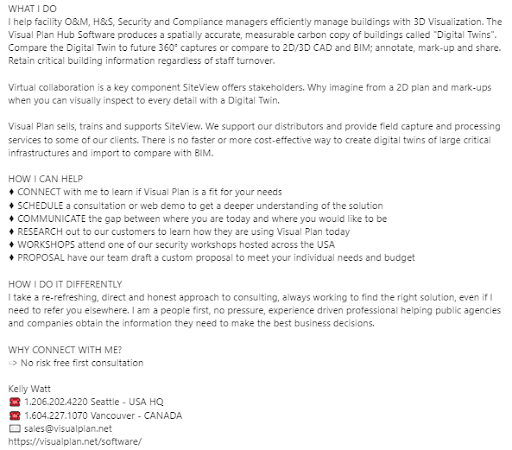
This is another straight-to-the-point example. It is well organized as it follows the structure:
- What I do
- How I can Help
- How I do it differently
- CTA
In addition, the author included many verbs and guided the prospects’ eyes by capitalizing them, which creates a sense of action.
Another great point is that he uses plain language and gives you the feeling he’s already part of the team.
Tips applied:
- Follows the structure;
- Keywords included;
- Summary written in the first person;
- Value offered to the prospects;
- Contact information included;
- CTA included;
- Text broken into small paragraphs.
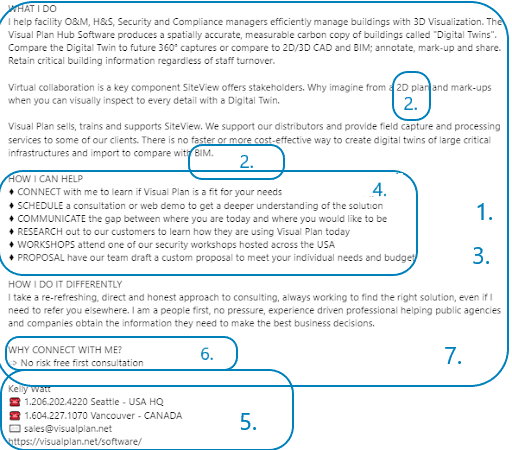
Summary about the LinkedIn summary
A well-crafted LinkedIn summary needs to compel your prospects to accept your invite and later on convert. Using any of these Linkedin Summary examples for sales will do just that, so we hope it will spark a bunch of new ideas for your own description.
First, think about how you want to present yourself on LinkedIn because the summary shows your personal brand. But do not forget, as a salesperson representing your company is that much more important.
To write the perfect LinkedIn summary, start with answering:
- Who are you, and what are your main work goals?
- What are you passionate about and why (customer-wise)?
- What is your job experience, and what have you accomplished?
- How can your product/service help prospects reach their goals?
After that, unleash yourself onto the Tips and Tricks checklist and decide if you wish to include all or some of them.
- Write your summary in the first person;
- Don’t be afraid to add some personality;
- Include some key search terms that your prospects will likely search (it will appear higher in LinkedIn search results);
- Add a context to your career;
- Let your summary be about the prospects and their goals also;
- Write common problems that you solved while focusing on the prospects greatest pain points;
- Speak about your biggest accomplishments;
- Share real metrics, awards, and figures about your accomplishments;
- Break up the content into short paragraphs and bullet points;
- Include a CTA message at the end;
- Bold or italicize parts of the text;
- Use emojis but do not overload;
- Include your contact information - make it easy for prospects to reach back to you;
- Use brief sentences.
Let the questions we mentioned be your guide, tips merely your way, and the examples your map to build a better LinkedIn summary.
Happy writing!
Are you using LinkedIn for prospecting and reaching out to your leads? Skylead is here to help you personalize, improve and maximize your outreach. See it in action - Try out Skylead for free.
Making your LinkedIn profile an exceptional one is a job half done!
That’s right. Your LinkedIn lead generation strategy or prospecting on LinkedIn might be impeccable. However, if your LinkedIn profile doesn’t give out the right first impression, all your efforts will go down the drain.
Taking into consideration that 80% of social media leads for the majority of B2B marketers come from LinkedIn, you will agree that it is of utmost importance how you present yourself professionally.
You’ve probably heard many times that it only takes around 7 seconds to form the first impression.
The same applies to your LinkedIn profile.
Therefore, an optimized profile not only boosts your visibility in the search results but also helps other LinkedIn users form a first impression of you as a professional.
That’s why we prepared 15 tips to make your LinkedIn profile more appealing to future leads and potential clients.
Your (profile) picture is worth a thousand words
The first thing people notice when they find you on LinkedIn is your profile picture, your name, and headline.
Your profile picture is your first chance to communicate that you are friendly, likable, and trustworthy, crucial attributes for people to engage with you.
Therefore, make sure that you look professional, yet approachable and open to networking.
However, keep in mind that LinkedIn is a professional network. Your profile is your brand.
Therefore, selfies, party pictures, and photos where you visibly had to cut someone else from it, as well as low-resolution photos, should not find their way to becoming your LinkedIn profile picture.
Examples:
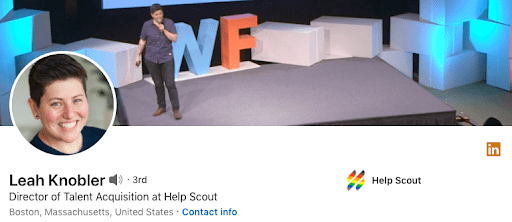
Leah Knobler went for an approachable, yet professional profile picture. She seems comfortable and open to networking. There is nothing distracting about the picture, such as her being in an informal setting. Quite the contrary, the blurred background keeps the focus on the actual user of this LinkedIn profile.
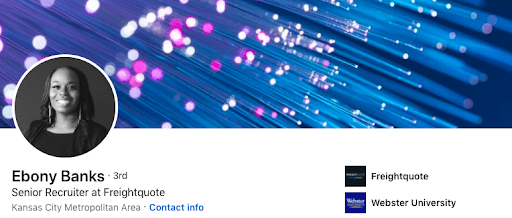
You can never go wrong with an en-face profile photo. Furthermore, Ebony Banks took a picture in a professional outfit with a matte background.

It is pretty self-explanatory why these pictures are inappropriate. LinkedIn is a professional network, and as much as you want to seem approachable, putting a party picture will for sure give out a wrong impression. Furthermore, posting a picture where someone has been visibly cut off, let’s be honest, doesn’t look neat on any social network.

The same rules apply to pictures that are visibly from private (non-business-related) events such as weddings. As much as you want to post a picture in a suit, make sure that you have a professional background, and that you are preferably not wearing a flower.
Move with the times: Add a cover story
The LinkedIn mobile app gives you the chance to create a 30-sec video and add it to your profile picture.
Namely, your LinkedIn profile photo will still be visible to other users. However, if you put a cover story as well, an orange ring will appear around it. It will be a sign that if they click on it, they will have the chance to know a bit more about you.
A cover story is a great way to introduce yourself better to other users, articulate your career goals, provide a sneak peek into your personality, and showcase your communication skills.
Additionally, LinkedIn gives you the option of adding three hashtags that best describe your topic. This way, you will give a short insight into your professional story to those who visit your LinkedIn profile.
Your cover has your back
Don’t underestimate the role of the cover photo in your LinkedIn profile aesthetics.
Data shows that humans only remember 20% of what they read, but 80% of what they see.
Having the logo of the company you work for or a creative yet connected to your professional background cover turned out to be making a major impact when connecting with other LinkedIn users.
Here are a few examples of highly creative, yet professional and industry-related cover photos.
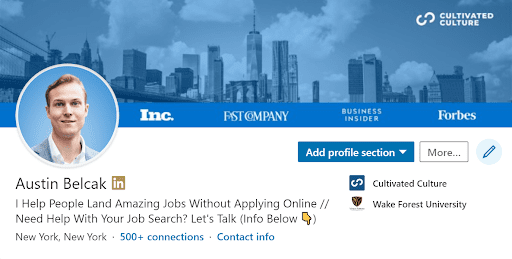
Austin Belcak went for the cover that showcases his company name, all the industry-related prominent magazines where it appeared, as well as the picture of the city where they are located.
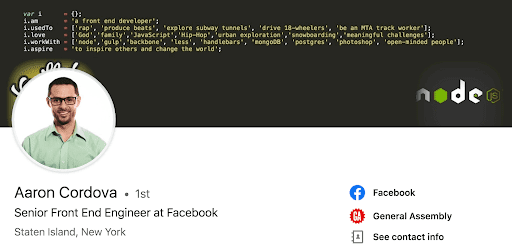
Aeron Cordova went for an “industry-related”, creative way to draw attention to his profile while listing his profession, interests, values, experience, and aspirations.
On the contrary, leaving your cover blank or putting a photo that is not relevant to your field, might seem unprofessional. It could leave your users with the impression that you don’t give much importance to your online resume.
For example, putting a picture of you doing yoga is acceptable only in case you work as a yoga instructor, or in that particular field. However, if you are a doctor or an engineer who does yoga as a hobby, this move might seem a bit awkward for those who are trying to connect with you on LinkedIn.
So, leave these choices for other, more casual, social media networks.
Win them over with your headline
Usually neglected and underused, the LinkedIn headline is the part of your profile that catches most of the attention.
“Content Marketing Consultant at Drift” is such a passé.
Therefore, be bold enough to go for more than just the default headline.
When deciding what you should write, think about:
- The benefits that people get out of working with you;
- The value that you bring to their businesses;
- The specific niche of your expertise;
- Including keywords that other users are likely to search.
For example:

Brent Morrell points out the benefits you can get out of working with him, such as growing your career.

Alexandra Sazonova highlights the value of her work in a particular area, such as healthcare.
If you would like to know more on how to write a good headline, check out our blog “13 LinkedIn headline examples with templates for lead generation". Get inspired!
Write an attention-grabbing summary
First of all, leaving the summary blank is a huge mistake!
With just a little bit of effort, you can write a great summary that draws the attention of your future leads, customers, or recruiters (depending on what your professional goals are at the moment).
When writing your summary section, have in mind that most users see only the first 300 characters (out of the total of 2000). Only if clicking on “Read more” will they get the full description.
Therefore:
- Start Strong;
- Use Keywords;
- Mention your greatest accomplishments;
- Point out your goals and ambitions;
- Include your guiding principles.
Here’s an example of an out-of-the-box, attention-grabbing summary.
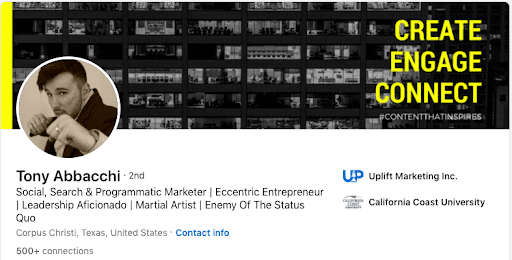

Or of a strictly professional, yet effective one.
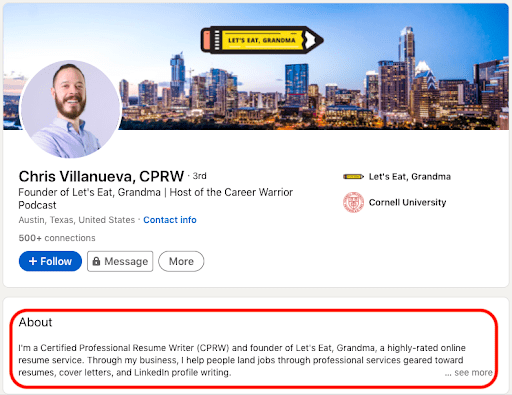
If you would like to know more about what makes the perfect summary, check out “top 5 summary examples to reach more sales”.
Grow your network
The first thing you can do to grow your network is to import your list of contacts.
Once you set up your profile, LinkedIn will give you the opportunity to run an upload of your address book contacts.
In case you skipped that step, and would like to do it at another time, follow these instructions:
- Click the My Network icon at the top of your LinkedIn homepage;

- Choose Connections on the left rail;
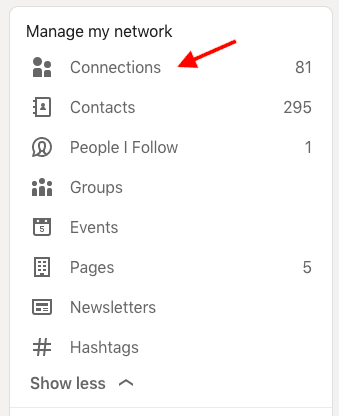
- Go for More options on the right rail;

- Type your email address in the field provided, or choose a service provider from the list below the text box. If your email provider is not supported, you can still invite people to connect by email;
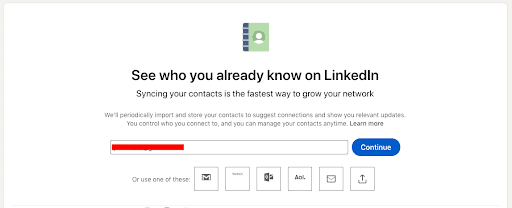
- Click Continue.
You’ll be redirected to a list of your contacts who are already on LinkedIn. You can:
- Check the boxes next to contacts you want to invite;
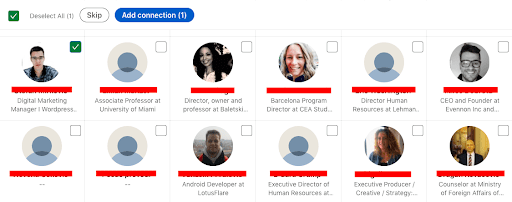
- Click Add Connections to send invitations;

- Click Skip if you don't want to invite anyone.

Of course, you can also add your connections manually through the search option at any time.
Show off your skills
The “Skills & Endorsements” section is one of the most important ones on your profile.
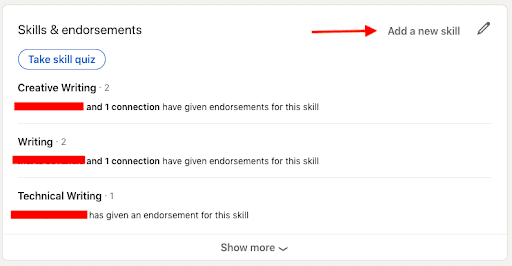
Did you know that people who have five or more skills listed are contacted up to 33 times more by recruiters and other LinkedIn members?
While you want to list a lot of skills, you also want to list the right skills.
Therefore, be honest with yourself and your profile visitors.
List the skills you truly possess and find relevant for your connections to know.
If you have difficulties specifying them, search for profiles with the same or similar job titles in your industry. See what skills these users have listed and check which ones apply to you and to what degree.
However, there is one catch. Once you delete a skill on LinkedIn, you cannot list it again. Be clever with what you choose and/or remove.
Endorse and you will be endorsed
Endorse others for their skills.
Not only is it polite to show some support to your 1st-degree connections, but they will also be more eager to endorse you.
The more endorsements you have, the more your LinkedIn profile will be appealing.
Furthermore, rumor has it that endorsements affect the algorithm. Namely, your profile is more likely to show up in searches if you have any. This is not confirmed, but even if it wasn’t true, having plenty of endorsements positively influences your acceptance and response rates for sure.
Besides the visibility, it simply gives out the impression of you being a well-skilled, responsible individual. And that is what all LinkedIn users want, right?
Get recommended
A recommendation is a commendation written by a LinkedIn member to recognize your work.

You can ask for a recommendation from the 1st-degree connections you work with or have worked with, whether a client or a colleague.

Having one or more recommendations on your LinkedIn profile will significantly boost your chances of getting noticed and/or accepted.
This means that you are the type of person who makes an impact at the workplace. Your colleagues value your contribution and are willing to put their name behind yours. It’s huge.
So if you think there are people who would gladly do that for you, go for it!
Include industry-related keywords
Whatever you are filling out at your LinkedIn profile, make sure to use the top keywords for your industry.
Before creating your online brand, think about which keywords are most sought for by your potential clients, co-workers, recruiters.
Once you have the list, use them wisely throughout your profile.
List your professional experience in a concise manner
Your LinkedIn profile is your online resume.
When you are sending your regular CV to employers or potential partners, it is not smart to list everything you’ve done so far. That is, only the most important jobs and projects find their place in your resume.
This should be the case with your LinkedIn profile as well.
List only those achievements that are relevant to your current professional field or to your future goals. Describe your duties and major accomplishments by using industry-related keywords while holding those positions.
This way you will give other LinkedIn users a significant insight into your professional experience without overwhelming them. Also, they will be more interested in reading your entire profile page. Seeing a bunch of unnecessary and incoherent information can just turn them down.
Fully complete your LinkedIn profile
Once you sign up for your profile the first time, LinkedIn will automatically guide you to fully complete it.

As you may see, LinkedIn will not only measure your profile strength but will also suggest (bottom right corner) what your profile is missing to be excellent.
LinkedIn wants you to prosper and expand your professional network. If you complete your profile, it will reward you with making you appear in search results up to 40 times more.
Get a custom URL
The majority of people use the URL that LinkedIn assigns automatically.
However, know that you can customize it and make it more appealing especially when posting it in your resume.
If you want to customize your LinkedIn profile URL:
- Click the Me icon at the top of your LinkedIn homepage.

- Choose View profile.
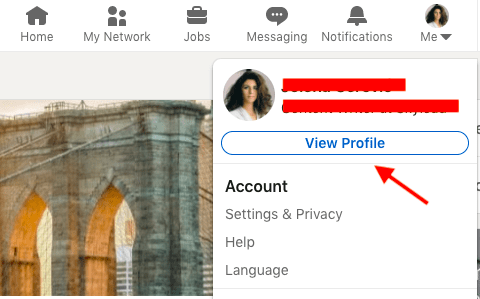
- Opt for Edit public profile & URL on the right side.

- You’ll be redirected to the Public profile settings page.
- Under Edit your custom URL on the right side, click the Edit icon next to your public profile URL.

- It'll be an address that looks like www.linkedin.com/in/yourname.
- Type the last part of your new custom URL in the text box.
- Click Save.
Have in mind that your custom URL can be 3-100 characters long. Don’t use spaces, symbols, or special characters. The customizable part of the URL is case insensitive. Whether you write christianwhite, Christianwhite, christianWhite, it will all point you out to the same profile.
You can change your URL up to 5 times within six months. Once you have changed your URL for the fifth time, you won’t be able to change it for another six months. Despite having the chance to customize your URL so many times, keep in mind that it will be hard for people to find you if you change it too often.
Brag a bit in your featured section
If you click on the “Add section” you can choose “Featured”, and write out or upload any posts, articles, links, or media that you find significant for your professional achievements.
This is a great place to highlight articles and blogs that you wrote, or in which you appeared. You can leave your company’s or your personal website, Youtube videos, or any other media you think might contribute to your professional prestige.
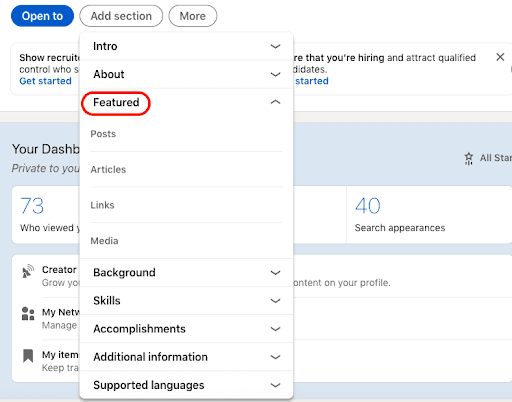
Share what moves you
Birds of a feather flock together.
The LinkedIn “Interests Area” gives you the chance to show your audience that you have a life outside of work. Have in mind that people do business with people, not machines. Therefore, by listing your interests that can and not necessarily need to be career-related, you will seem more approachable, and other users might be more likely to do business with you.

Additionally, listing your interests will not only say a lot about you, but it will also be useful for the LinkedIn search engine. People might run into your profile by researching certain interests you share (or not).
Summary
Whether you are doing a LinkedIn outreach or you just appear in somebody’s search results, your LinkedIn profile is a synonym for the powerful first impression. Or quite the opposite.
Therefore, make sure it’s on point.
Also, in case you are going for an automated outreach, Skylead might just be the right choice for you.
Schedule a demo call with our specialist and see how you can benefit from everything that Skylead has to offer.
If you are already a user and have questions about improving your outreach, feel free to reach out to our customer care and success team via chat on our website!
We are waiting for you.

